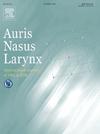Objective evaluation for Endoscopic Sinus Surgeries’ proficiency by image analysis for postoperative 3D sinus models
IF 1.5
4区 医学
Q2 OTORHINOLARYNGOLOGY
引用次数: 0
Abstract
Objective
Objective assessment for endoscopic sinus surgery skill proficiency is challenging, partly due to the great diversity of anatomies. Recently developed 3D-printed sinus models provide standardized anatomy with realistic tissue-feel. In this study, we developed a method to evaluate endoscopic sinus surgery skill proficiency through pre- and post-operative image analysis of CT images of dissected 3D sinus models and validated it by comparing to other surgical proficiency indices.
Methods
Forty-seven otolaryngologists performed endoscopic sinus surgery for 3D sinus models. CT images of each postoperative 3D model were taken. The region growing method, an image segmentation technique, was utilized to assess the surgical space expansion. The region of interest (ROI) was defined as the space within nasal cavity and paranasal sinuses and continuous from the anterior nostril with a width of >4.00 mm kept. The volume of ROI was estimated and compared with conventional assessment methods such as board-certification, the objective structured assessment of technical skills score, and the number of experienced surgery cases. Further, the 3D-CG images of ROI were created. The completion of surgical steps within the allocated time was evaluated based on the 3D-CG and compared with the recorded endoscopic video.
Results
The volume in postoperative models was 24.48±4.34 cm3 across all participants, respectively. The postoperative volume was significantly larger in board-certified participants (certified; 25.51±4.22 cm3 vs. uncertified; 22.87±4.14 cm3, p = 0.03). The volume is positively correlated to the objective structured assessment of technical skills score (r = 0.72, p < 0.01) and the number of experienced cases (r = 0.51, p = 0.01). The accuracy of the 3D-CG judgement for completion of a surgical middle meatal antrostomy, sphenoidotomy, and frontal sinusotomy were 91.3 %, 69.6 %, and 84.8 %, when compared to recorded endoscopic video, with high sensitivity and specificity.
Conclusion
The combination of standardized 3D models and image analysis provides a simple and objective tool for the assessment of surgical skill proficiency.
目的通过对鼻窦术后三维模型的图像分析,评价鼻窦内镜手术的熟练程度
目的客观评估内窥镜鼻窦手术技术熟练程度是具有挑战性的,部分原因是解剖结构的多样性。最近开发的3d打印鼻窦模型提供了具有真实组织感觉的标准化解剖结构。在本研究中,我们通过对解剖的三维鼻窦模型的CT图像进行术前和术后图像分析,建立了一种评估内镜鼻窦手术技能熟练度的方法,并通过与其他手术熟练度指标进行比较验证。方法47名耳鼻喉科医师对三维鼻窦模型进行内窥镜手术。取术后各三维模型的CT图像。利用图像分割技术——区域生长法来评估手术空间的扩展。感兴趣区(ROI)定义为鼻腔和鼻窦内的空间,从前鼻孔开始连续,宽度为4.00 mm。评估ROI的数量,并与传统的评估方法如委员会认证、客观结构化的技术技能评分、经验手术例数等进行比较。在此基础上,建立了ROI的3D-CG图像。根据3D-CG评估手术步骤在规定时间内的完成情况,并与记录的内镜视频进行比较。结果所有参与者术后模型的体积分别为24.48±4.34 cm3。经委员会认证的参与者术后体积明显更大(经认证者25.51±4.22 cm3 vs.未经认证者22.87±4.14 cm3, p = 0.03)。容积与客观结构化技术技能评估得分(r = 0.72, p < 0.01)和经验案例数(r = 0.51, p = 0.01)呈正相关。3D-CG对手术中颅口吻合、蝶窦切开术和额窦切开术的判断准确度与内镜录像相比分别为91.3%、69.6%和84.8%,具有较高的敏感性和特异性。结论标准化的三维模型与图像分析相结合,为外科手术技能熟练程度的评估提供了一种简单、客观的工具。
本文章由计算机程序翻译,如有差异,请以英文原文为准。
求助全文
约1分钟内获得全文
求助全文
来源期刊

Auris Nasus Larynx
医学-耳鼻喉科学
CiteScore
3.40
自引率
5.90%
发文量
169
审稿时长
30 days
期刊介绍:
The international journal Auris Nasus Larynx provides the opportunity for rapid, carefully reviewed publications concerning the fundamental and clinical aspects of otorhinolaryngology and related fields. This includes otology, neurotology, bronchoesophagology, laryngology, rhinology, allergology, head and neck medicine and oncologic surgery, maxillofacial and plastic surgery, audiology, speech science.
Original papers, short communications and original case reports can be submitted. Reviews on recent developments are invited regularly and Letters to the Editor commenting on papers or any aspect of Auris Nasus Larynx are welcomed.
Founded in 1973 and previously published by the Society for Promotion of International Otorhinolaryngology, the journal is now the official English-language journal of the Oto-Rhino-Laryngological Society of Japan, Inc. The aim of its new international Editorial Board is to make Auris Nasus Larynx an international forum for high quality research and clinical sciences.
 求助内容:
求助内容: 应助结果提醒方式:
应助结果提醒方式:


